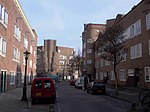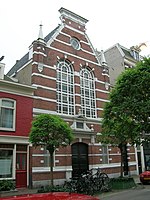De Pijp

De Pijp (English: The Pipe) is a neighbourhood of Amsterdam, Netherlands. It is located directly south of Amsterdam's city centre and it is part of the borough Amsterdam-Zuid, in a part of the city known as the Old South (Oud Zuid). It is served by De Pijp metro station. Most streets in De Pijp are named after Dutch painters, like Jan Steen, Frans Hals, Ruysdael and Vincent van Gogh. Diamantbuurt, Nieuwe Pijp and Oude Pijp are the three districts composing the area. The busiest street market of the Netherlands, the Albert Cuyp Market, is located in De Pijp. It is open six days per week and attracts tourists. The former Heineken brewery is also a local tourist attraction; the former town hall of Nieuwer-Amstel is one of De Pijp's most notable monuments. Next to the former Heineken brewery is the Marie Heinekenplein, which has a number of bars and cafes. Along the canal Ruysdaelkade, there is a small red-light district. De Pijp is densely populated and has a diverse population, with a relatively high percentage of highly educated people and people living alone. Notable people to have lived in De Pijp include painter Piet Mondriaan, folk singer André Hazes, as well as actress Carice van Houten. In 2013, Mano Bouzamour published a much-disputed novel about growing up as an immigrant in this neighbourhood.
Excerpt from the Wikipedia article De Pijp (License: CC BY-SA 3.0, Authors, Images).De Pijp
Van Ostadestraat, Amsterdam Zuid
Geographical coordinates (GPS) Address Nearby Places Show on map
Geographical coordinates (GPS)
| Latitude | Longitude |
|---|---|
| N 52.353055555556 ° | E 4.8961111111111 ° |
Address
Van Ostadestraat 165-H
1073 TK Amsterdam, Zuid
North Holland, Netherlands
Open on Google Maps









